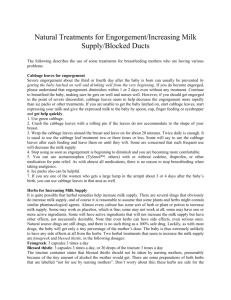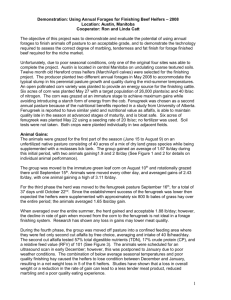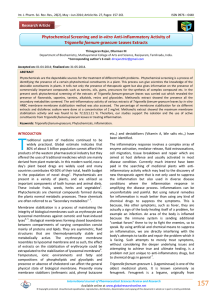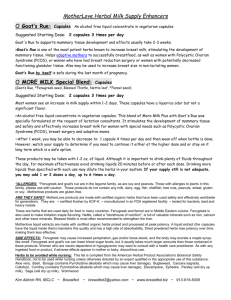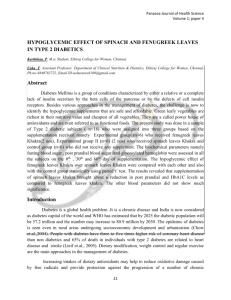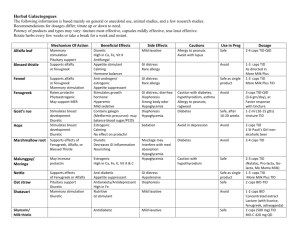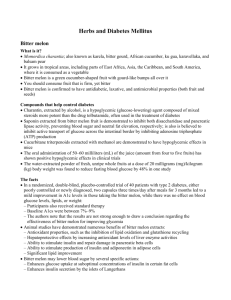Document 13309903
advertisement
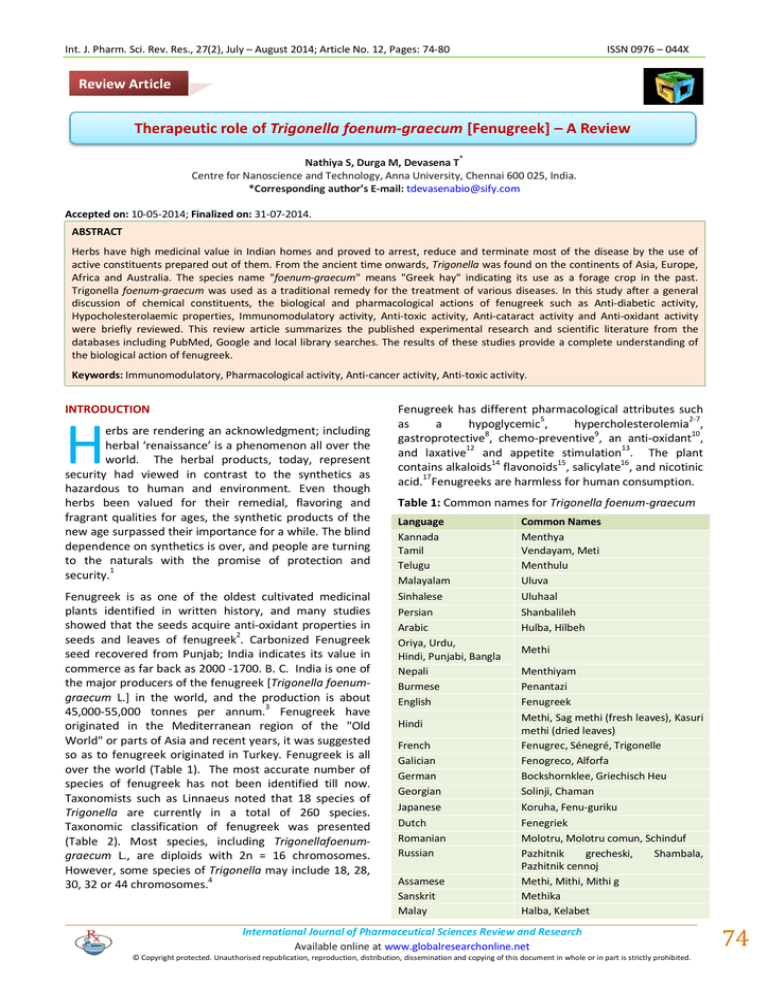
Int. J. Pharm. Sci. Rev. Res., 27(2), July – August 2014; Article No. 12, Pages: 74-80 ISSN 0976 – 044X Review Article Therapeutic role of Trigonella foenum-graecum [Fenugreek] – A Review * Nathiya S, Durga M, Devasena T Centre for Nanoscience and Technology, Anna University, Chennai 600 025, India. *Corresponding author’s E-mail: tdevasenabio@sify.com Accepted on: 10-05-2014; Finalized on: 31-07-2014. ABSTRACT Herbs have high medicinal value in Indian homes and proved to arrest, reduce and terminate most of the disease by the use of active constituents prepared out of them. From the ancient time onwards, Trigonella was found on the continents of Asia, Europe, Africa and Australia. The species name "foenum-graecum" means "Greek hay" indicating its use as a forage crop in the past. Trigonella foenum-graecum was used as a traditional remedy for the treatment of various diseases. In this study after a general discussion of chemical constituents, the biological and pharmacological actions of fenugreek such as Anti-diabetic activity, Hypocholesterolaemic properties, Immunomodulatory activity, Anti-toxic activity, Anti-cataract activity and Anti-oxidant activity were briefly reviewed. This review article summarizes the published experimental research and scientific literature from the databases including PubMed, Google and local library searches. The results of these studies provide a complete understanding of the biological action of fenugreek. Keywords: Immunomodulatory, Pharmacological activity, Anti-cancer activity, Anti-toxic activity. INTRODUCTION H erbs are rendering an acknowledgment; including herbal ‘renaissance’ is a phenomenon all over the world. The herbal products, today, represent security had viewed in contrast to the synthetics as hazardous to human and environment. Even though herbs been valued for their remedial, flavoring and fragrant qualities for ages, the synthetic products of the new age surpassed their importance for a while. The blind dependence on synthetics is over, and people are turning to the naturals with the promise of protection and security.1 Fenugreek is as one of the oldest cultivated medicinal plants identified in written history, and many studies showed that the seeds acquire anti-oxidant properties in seeds and leaves of fenugreek2. Carbonized Fenugreek seed recovered from Punjab; India indicates its value in commerce as far back as 2000 -1700. B. C. India is one of the major producers of the fenugreek [Trigonella foenumgraecum L.] in the world, and the production is about 45,000-55,000 tonnes per annum.3 Fenugreek have originated in the Mediterranean region of the "Old World" or parts of Asia and recent years, it was suggested so as to fenugreek originated in Turkey. Fenugreek is all over the world (Table 1). The most accurate number of species of fenugreek has not been identified till now. Taxonomists such as Linnaeus noted that 18 species of Trigonella are currently in a total of 260 species. Taxonomic classification of fenugreek was presented (Table 2). Most species, including Trigonellafoenumgraecum L., are diploids with 2n = 16 chromosomes. However, some species of Trigonella may include 18, 28, 4 30, 32 or 44 chromosomes. Fenugreek has different pharmacological attributes such as a hypoglycemic5, hypercholesterolemia2-7, 8 gastroprotective , chemo-preventive9, an anti-oxidant10, and laxative12 and appetite stimulation13. The plant contains alkaloids14 flavonoids15, salicylate16, and nicotinic acid.17Fenugreeks are harmless for human consumption. Table 1: Common names for Trigonella foenum-graecum Language Kannada Tamil Telugu Malayalam Sinhalese Persian Arabic Oriya, Urdu, Hindi, Punjabi, Bangla Nepali Burmese English Hindi French Galician German Georgian Japanese Dutch Romanian Russian Assamese Sanskrit Malay Common Names Menthya Vendayam, Meti Menthulu Uluva Uluhaal Shanbalileh Hulba, Hilbeh Methi Menthiyam Penantazi Fenugreek Methi, Sag methi (fresh leaves), Kasuri methi (dried leaves) Fenugrec, Sénegré, Trigonelle Fenogreco, Alforfa Bockshornklee, Griechisch Heu Solinji, Chaman Koruha, Fenu-guriku Fenegriek Molotru, Molotru comun, Schinduf Pazhitnik grecheski, Shambala, Pazhitnik cennoj Methi, Mithi, Mithi g Methika Halba, Kelabet International Journal of Pharmaceutical Sciences Review and Research Available online at www.globalresearchonline.net © Copyright protected. Unauthorised republication, reproduction, distribution, dissemination and copying of this document in whole or in part is strictly prohibited. 74 Int. J. Pharm. Sci. Rev. Res., 27(2), July – August 2014; Article No. 12, Pages: 74-80 Table 2: Taxonomy of Trigonella foenum-graecum Kingdom Super division Plantae Angiosperms Division Eudicots Class Rosids Order Fabales Family Fabaceae Subfamily Faboideae Tribe Trifolieae Genus Trigonella Species Foenum The biological and pharmacological effects of fenugreek has related to the variety of its components namely, steroids, N-compounds, polyphenolic substances, volatile constituents, and amino acids etc.18 Fenugreek 45-60%, (galactomannans), 20-30% proteins high in lysine tryptophan, 5-10% (lipids), pyridine alkaloids, trigonelline (0.2-0.38%), choline (0.5%), carpaine gentianine, flavonoids luteolin, apigenin, quercetin, orientin, isovitexin vitexin, amino as 4hydroxyisoleucine (0.09%), histidine, arginine lysine, calcium, saponins, glycosides steroidal sapogenins on hydrolysis (yamogenin, diosgenin, neotigogenin, tigogenin), sitosterol cholesterol, vitamin A, B1, C nicotinic18-20. The chemical constituents are increased in the seeds at the time of growing period by using different cultural techniques21-22, or during post-harvest treatments 23 , by storage23,by the use of tissue and cell culture (static or suspension) 25-26, and by biological manipulation of yield 19, 24, 27. PHARMACOLOGICAL ACTIONS OF FENUGREEK Anti-diabetic activity The harmful side effects of synthetic drugs, the enormous cost and the in ability of existing modern therapies to control all pathological aspects and the poor advance therapies for many rural populations in developing countries are the major drawback of synthetic drugs, to overcome these issues the plant compounds are used now a days, fenugreek plays a vital role in treating several diseases. The anti-diabetic activity of fenugreek was briefly discussed.Postprandial blood glucose response has reduced by soluble fiber, Galactomannan, it is isolated from Canadian grown fenugreek seeds. In vitro studies were conducted to identify the effect of galactomannan on intestinal glucose uptake in genetically determined lean and obese rats. The viscosity of different combinations of galactomannan solutions was prepared. The galactomannan as of the viscous property it has potential to reduce intestinal absorption of low or high concentration of glucose and; therefore for the benefit of blood glucose control.31 ISSN 0976 – 044X The anti-diabetic properties of a Soluble Dietary Fibre [SDF] fraction of Trigonella foenum-graecum were evaluated. Administration of SDF fraction [0.5 g/kg body weight] to normal, type 1 or type 2 diabetic rats significantly improved oral glucose tolerance. Effects of soluble dietary fibre of Trigonella foenum-graecum on sucrose absorption from the gut, on intestinal glucose absorption, on intestinal disaccharidase activity and gastrointestinal motility, on insulin secretion, on glucose uptake and insulin action were determined.They demonstrated that SDF fraction of Trigonella foenumgraecum significantly improved glucose homeostasis in type I and type II diabetes by delaying carbohydrate digestion and absorption, and enhancing or mimicking insulin action. After oral sucrose ingestion in non-diabetic and type 2 diabetic rats, SDF fraction suppressed the elevation of blood glucose. Glucose transport in 3T3-L1 adipocytes and insulin action was increased by Trigonella foenum-graecum. They indicated that the SDF fraction of Trigonella foenum-graecum seeds applies anti diabetic effects mediated during inhibition of absorption and carbohydrate digestion, and enhancement of peripheral insulin action.32 The effect of oral administration of Fenugreek whole seed powder [5% in the diet] for 21 days in alloxan-induced diabetic Wistar rats were studied, the glycolytic, gluconeogenic and NADP linked lipogenic enzymes were determined in the liver and kidney tissues of rats.33 Fenugreek seed powder treatment to diabetic rats for 21 days brought down the high fasting blood glucose levels to control levels. The altered enzyme activities were restored to control values in both the liver and kidney after fenugreek seed powder treatment. The biochemical effects exerted by fenugreek seeds make it a potential new curative effect in type-1 diabetes. The anti-diabetic actions of fenugreek seeds in part have been considered as to the presence of steroid, saponins and fibre content in the seeds.34 The isolation of furostanol saponins called trigoneosides, 35 glycoside D and trigofoenoside A and the determination 36 of steroidal sapogenins like diosgenin and yamogenin were identified in the fenugreek. Pharmacological experiments performed in vivo in normal and streptozotocin induced diabetic rats resulted in increased food intake and consequent progressive weight gain in the diabetic rats treated with the furostanol saponins, in contrast to the untreated diabetic rats.37 It was identified that Trigonella seed powder treatment to diabetic rats affects key glycolytic, gluconeogenic and NADH-linked lipogenic enzymes. The change in the activities of enzymes effected by Trigonella seed powder treatment as elucidated in this study suggest that a normal glucose metabolism, in peripheral tissues such as liver and kidneys, is critical in achieving normoglycemia.Intermit therapy is possible with the potent product GII of fenugreek which is of great benefit in diabetes induced rabbits.38 International Journal of Pharmaceutical Sciences Review and Research Available online at www.globalresearchonline.net © Copyright protected. Unauthorised republication, reproduction, distribution, dissemination and copying of this document in whole or in part is strictly prohibited. 75 Int. J. Pharm. Sci. Rev. Res., 27(2), July – August 2014; Article No. 12, Pages: 74-80 The effect of fenugreek saponin in diabetic rats was analysed. The fenugreek saponin fraction significantly modulated the disaccharidase and glycogen enzyme activities in the intestine; it increased the hepatic glycogen content, suppressed the increase of blood glucose level and improved results in the Oral Glucose Tolerance Test [OGTT]. The fenugreek saponin extract also efficiently protected the hepatic function, which was by the significant increases of superoxide dismutase [SOD], catalase [CAT], gluthation peroxidase [GPX], aspartate transaminase [AST], alanine transaminase [ALT] and lactate dehydrogenase [LDH] enzyme activities. Fenugreek saponins reveal attractive properties and can be considered as capable candidates for potential purpose as therapeutic agents in biotechnological with bioprocess based technologies, mainly those related to the improvement of anti-diabetic, hepatoprotective and 39 hypolipidemic drugs. Lipid profile Atherosclerosis and its problems compose the mainly common cause of death in Western societies. Oxidative modification of LDL [low-density lipoprotein] is an important, if not obligatory event in atherosclerosis.40 Inhibition of LDL oxidation can lessen the risk of atherosclerosis independent of reducing plasma cholesterol levels41. A diet rich in fibre and vegetables has to reduce the atherogenesis and it is the first line of management. The effect of fenugreek on blood lipids, blood sugar, platelet aggregation, fibrinogen and fibrinolytic activity were assessed. Healthy individuals, patient of Coronary Artery Disease [CAD], and patients with Non-insulin Dependent Diabetes Mellitus [NiDDM], who either had CAD or were without CAD. Fenugreek given in a dose of 2.5g twice daily for 3 month to healthy individuals does not change the blood lipids and blood sugar [fasting and post prandial]. Though, administered in the same daily dose for some duration to CAD patients also with NiDDM, fenugreek significantly reduce the blood lipids without affecting the HDL-C while administered in the same daily dose to NiDDM patient [mild cases], fenugreek reduced the blood sugar. In severe NiDDM cases, the blood sugar was only slightly reduced; fenugreek did not affect platelet aggregation, fibrinolytic activity and fibrinogen.42 The hypocholesterolemic properties of ethanol extract from defatted fenugreek seeds were studied. Purification of the crude extracts by dialysis produced an isolated component with hemolytic characteristics. The dialysate wasalsofound to include saponins shown by thin-layer chromatography. In two separate feeding trials, hypercholesterolaemic rats were supplied on 30 or 50 g ethanol extract/kg for a 4-week time. Reductions in plasma cholesterol levels ranged from 18 to 26%, and a tendency for lower concentrations of liver cholesterol was examined. The ethanol extract from fenugreek seeds contained hypocholesterolemic components that look to be, saponins that interact with bile salts in the digestive ISSN 0976 – 044X tract. The focus on the contribution of an ethanol [EtOH] extracts obtained from ground fenugreek seeds in reducing cholesterol levels in hypercholesterolemic rats.43 Hence, fenugreek contains biologically-active components 44- 46 which do not directly, interact with cholesterol. In order to investigate how chemically diverse fibres differ in their hypolipidemic activity, mucilage of varying chemical composition isolated from three different sources were administered to experimental animals, and the metabolism of lipids and lipoproteins was studied. One of the mucilage used was a galactomannan isolated from fenugreek [Trigonellafoenum graecum] seeds.47 Rats were fed with mucilage at a dose of 4 mg/100 g body weight per day for 8 weeks, and changes in the levels of total cholesterol and triacylglycerols in serum, liver and aorta were analysed. A greater lipid-lowering effect was shown by mannans like Glucomannan and galactomannan than arabinogalactan. The hypolipidemic effect of this mucilage appears to be due to a decrease in the synthesis and secretion of VLDL by hepatocytes. A reduction in production of VLDL can be due to a reduction in the 48 synthesis of apoB as well as lipids associated with VLDL. Polyphenols present in fenugreek seeds play a significant role in mitigating lipid abnormalities and maintaining collagen content and properties during alcohol-induced liver damage. Besides the prevention of collagen cross linking, the benefits of fenugreek might be related to antiinflammatory activity and effects on IL-6, TNF-α, and enzyme systems responsible for collagen synthesis and degradation.49 The impact of a novel fibre mix of fenugreek seed powder, guar gum and wheat bran [Fibernat] on LDL oxidation was evaluated.50 Fibernat administration thus prevented the oxidative modification of LDL; the LDL + VLDL fraction also displayed a resistance to oxidative modification. Plasma antioxidant status with respect to GSH was enhanced. In general, these studies imply that Fibernat intake could reduce the risk for atherosclerosis and other disorders of lipid metabolism in rats. Immunomodulatory and anti-toxic activity Immunomodulatory activity of the aqueous extract of fenugreek was assessed in male swiss albino mice. Mice were treated with three doses of extract [50, 100, 250 mg/kg body weight] for 10days. The response at the higher dose, i.e. at 250 mg/kg, was either identical to control group animals or mildly stimulated as compared to control animals. The increase in thymus weight was accompanied by an increase in its cell counts. This may be partly due to the stimulatory effect of plant extract on the lymphocytes and bone marrow hematopoietic cells, which ultimately home in the thymus. Trigonella foenum graecum showed stimulatory effects on macrophages. Phagocytosis of microorganisms by macrophages of 51 against Trigonella foenum graecum has immune 52 stimulatory. International Journal of Pharmaceutical Sciences Review and Research Available online at www.globalresearchonline.net © Copyright protected. Unauthorised republication, reproduction, distribution, dissemination and copying of this document in whole or in part is strictly prohibited. 76 Int. J. Pharm. Sci. Rev. Res., 27(2), July – August 2014; Article No. 12, Pages: 74-80 Cypermethrin [CM] is an important type II pyrethroid pesticide used widely in pest control and is to cause hepatic and renal toxicity. Oxidative stress and lipid peroxidation [LPO] havebeeninvolved in the toxicology of pyrethroids. The protective power of aqueous extract of germinated fenugreek seeds in CM-induced hepatic and renal toxicity were studied. CM treatment has caused increases thiobarbituric acid reactive substances [TBARS], depletion in glutathione [GSH] and decrease in the activities of superoxide dismutase [SOD], catalase [CAT], glutathione peroxidase [GPx] and glutathione-Stransferase [GST] in the liver and kidneys. The activities of tissue antioxidants SOD, CAT, GPx and GST, decreased significantly [p < .05] in CM-treated rats while the CM and germinated fenugreek seed extract treated rats displayed a notable increase [p < .05] in all the tissue antioxidants when compared with the CM-treated rats. Aqueous extract of fenugreek was reported to ameliorate additive urotoxicity of buthionine, sulfoximine and cyclophosphamide by restoring the anti-oxidant status and reversing the cyclophosphamide-induced apoptosis in 54 free radical-mediated LPO in the urinary bladder. Fenugreek in the diet showed a marked reduction in diabetes-induced polydypsia, hyperglycemia, polyuria, urine sugar, renal hypertrophy and glomerular filtration rate.55 Numerous useful physiological properties and strong antioxidant potential and its widespread availability, the neutraceutical value of fenugreek makes it an ideal candidate to protect against pesticide-induced toxicity and the inhibition of fenvalerate toxicity in vitro by fenugreek seeds in blood samples of healthy human volunteers [22-26 years].56 Anti-cataract Activity Cataract is the opacification in the eye lens and leads to 50% of blindness worldwide. Cataract remains the leading cause of visual disability, and it contributes 50% blindness worldwide.57Several risk factors have been known in the pathogenesis of senile cataract. Despite aging, diabetes, smoking, gender, steroids, and nitric oxide are liable for 58 the growth of cataract. The anti-cataract potential of Trigonella foenum-graecum L seeds [fenugreek] in selenite-induced in vitro and in vivo cataract was evaluated. In vitro enucleated rat lenses were maintained in organ culture containing Dulbecco’s modified Eagles medium [DMEM] alone or in addition with 100 µM selenite and served as standard and control groups, respectively. For the test group, the medium was supplemented with selenite and Trigonella foenumgraecum aqueous extract. The lenses were incubated for 24 h at 37°C. After incubation, the lenses were processed for the estimation of reduced glutathione [GSH], lipid peroxidation product [malondialdehyde], and the antioxidant enzymes. A fall in GSH and a rise in malondialdehyde levels were seen in control as compared to standard lenses. Trigonella foenum-graecum drastically ISSN 0976 – 044X [P< 0.01] restored glutathione and decreased malondialdehyde levels. An important restoration in the activities of anti-oxidant enzymes such as superoxide dismutase (P<0.01), catalase, (P<0.01), glutathione peroxidase (P<0.01), and glutathione-S-transferase (P<0.01) was observed in the Trigonellafoenum-graecum supplemented group as compared to control. Trigonellafoenum-graecum protects against the experimental cataract by virtue of its anti-oxidant properties. GSH level in the normal group was found to be 1.19±0.24 µmol/g. There was a significant reduction, in GSH level, in the presence of selenite stress, and the level was found to be 0.11± 0.05 µmol/g of lens in the control group. Fenugreek supplemented group significantly restored the GSH level in a dose-dependent manner. It was observed that, in the presence of selenite stress, antioxidant enzymes were reduced as compared with the 59 average group. Anti-oxidant activity Crude extracts of fenugreek were prepared by soxhelt extraction process with different solvents such as ethanol, methanol, acetone, ethyl acetate, dichloromethane and hexane. Extracts were subjected for the measurement of total phenolic content by Folin-Ciocalteu method as well as chelating activity, flavonoid content, antioxidant/radical scavenging activity, reducing powder and free radical scavenging activity. The results show that all extracts of the fenugreek exhibit anti-oxidant activity. The seeds include rich proteins and mucilaginous fiber and other rare chemical constituents such to account for muchcholesterol to sugar levels.60-62 Ethanolic extract of fenugreek seeds was shown highest anti-oxidant activity [% DPPH scavenging activity]. The anti-oxidant activity could be associated with the polyphenolic components present in the extract.63 Fenugreek seeds could modulate the activity of glyoxalase system SOD, catalase and GST. Fenugreek seeds seem to have a dual effect on the tissues as is visible from the enhanced anti-oxidant state at lower doses and prooxidant effect at higher doses. Anti-diabetic and hypoglycemic properties could be connected, to its ability to increase the activity of gly I and anti-oxidant potential.64 Associated use of fenugreek might lower serum glucose level65and its mucilage possesses a hypolipidemic effect. The anti-hypercholesterolemic and anti-atherogenic effects of the mucilage galactomannan isolated from fenugreek seeds were also studied in experimental rabbits.66 An aqueous extract of; fenugreek seeds were examined for its anti-radical and in vitro anti-oxidant activity in different model systems. The radical activity could be correlated with the polyphenolic compound present in the extract, and the result of this process provides some important factors responsible for anti67-68 oxidant potentials of fenugreek seeds. International Journal of Pharmaceutical Sciences Review and Research Available online at www.globalresearchonline.net © Copyright protected. Unauthorised republication, reproduction, distribution, dissemination and copying of this document in whole or in part is strictly prohibited. 77 Int. J. Pharm. Sci. Rev. Res., 27(2), July – August 2014; Article No. 12, Pages: 74-80 Thefunctional food quality of fenugreek seeds were assessed by determining the lipid peroxidation [LPO] and cyclooxygenase enzyme [COX] inhibitory activities in hexane, ethyl acetate, methanolic and water extracts using MTT, LPO, COX-1 and COX-2 enzyme inhibitory assays. The extracts inhibited LPO by 55–95%, COX-1 by 6–87% and COX-2 by 36–70%, respectively, at 250 g/ml. Bioassay-guided purification of these extracts yielded triglycerides, fatty acids, saccharides and flavonoid-Cglycosides. The antioxidant and anti-inflammatory activities exhibited by the isolated compounds from fenugreek seeds support its anecdotal health 69 applications. Other medicinal uses The fenugreek seeds are important in keeping a healthy digestive system; thus the continue, and daily use of this spice may increase the digestibility of eaten food, which may further promote good absorbing capacity of food constituents in blood for best metabolic use in the body cells. Fenugreek seeds have restorative and nutritive ISSN 0976 – 044X properties. The daily use of fenugreek seeds as the dietary supplement is safe. It has good beneficial effects to increase blood Hg by natural means. This might extra help avoid and cure anemia and have good healthy life for 70 longer duration in females of child bearing age. Modulatory effect of fenugreek seeds on 1, 2dimethylhydrazine-induced hepatic oxidative stress during colon carcinogenesis was studied in male wistar rats.71 It was identified that in pulverized seed of fenugreek in the diet of DMH treated rats reduced the colon incidence up to 16.6%. Acetylcholinesterase inhibitors [AChEI] give a significant relief to some of the clinical signs of the disease. They studied to regulate the extract of fenugreek with trigonelline by HPTLC method and determine the in vitro AChE inhibitory activity of fenugreek and its components using galantamine as a reference. From this, they showed that the fractions and trigonelline fenugreek seed has a potential AChE inhibitory activity and could be used for the cure of Alzheimer’s disease.72 Table 3: Potential Medicinal Values of Trigonella foenum-graecum Traditional Uses To treat arthritis, asthma, bronchitis, improve digestion, increase libido and male potency, to cure skin problems (wounds, rashes and boils), to treat sore throat, and cure acid reflux, treatment of reproductive disorders, to induce labor, to treat hormonal disorders, to help with breast enlargement, and to reduce menstrual pain, blood Sugar Regulation Pharmacological Activities Anti-diabetic Anti-inflammatory Anti-toxic Anti-cancer Hypoglycemic, hypercholesterolemia, gastroprotective, chemopreventive, antioxidant, laxative, appetite stimulation, Anti-cataract, Immunomodulatory activity, Anti-atherogenic CONCLUSION The Present review highlights the value of different pharmacological activities of Trigonella foenum-graecum (Table 3). Enormous studies were done for this plant; however novel therapeutic activities were briefly discussed in this study. Thus anti-toxic potential, anticataract effect of this plant is a significant pharmacological activity, which should be focused more in the future. Acknowledgement: The author would like to acknowledge DST, New Delhi for providing financial assistance under DST- INSPIRE Scheme, Proceeding No: 8946/ PD6/2010. REFERENCES 1. Joy PP, Thomas J, Mathew S, Baby P Skaria, Medicinal plants, Kerala agricultural university, Aromatic and Medicinal plants research station, Kerala. Side Effects of Fenugreek Minor side effects such as Nausea, Gastrointestinal discomfort (diarrhea and/or gas) 2. Srinivasan K, Fenugreek (Trigonella foenum-graecum): A review of health beneficial physiological effects, Food-Reviews- International, 22, 2006, 203–224. 3. Vikas S,Indian Agriculture, Economic Data Research Center, New Delhi, India, 2003, 585–587. 4. Acharya SN, Thomas JE, Bas SK,Fenugreek: an "old world" crop for the "New world”, Biodiversity,7, 2006, 3-4. 5. Sharma RD, Raghuram TC, Rao NS, Effect of fenugreek seeds on blood glucose and serum lipids in type I diabetes, Eur. J. Clin. Nutr, 44, 1990, 301–306. 6. Zia T, Nazrul Hasnain S,Hasan SK, Evaluation of the oral hypoglycaemic effect of Trigonella foenum-graecum L. in normal mice, Journal of Ethnopharmacology, 75, 2001,191–195. 7. Stark A, Madar Z, The effect of an ethanol extract derived from fenugreek (Trigonella foenum-graecum) on bile acid absorption and cholesterol levels in rats, British Journal of Nutrition, 69, 1993, 277– 287. 8. Suja Pandian R, Anuradha CV, Viswanathan P, Gastroprotective Effect of fenugreek seeds (Trigonella foenum graecum) on experimental gastric ulcer in rats, J Ethnopharmacol, 81, 2002, 393– 397. International Journal of Pharmaceutical Sciences Review and Research Available online at www.globalresearchonline.net © Copyright protected. Unauthorised republication, reproduction, distribution, dissemination and copying of this document in whole or in part is strictly prohibited. 78 Int. J. Pharm. Sci. Rev. Res., 27(2), July – August 2014; Article No. 12, Pages: 74-80 ISSN 0976 – 044X 9. Amin A, Alkaabi A, Al-Falasi S, Daoud SA, Chemopreventive activities of Trigonella foenum-graecum (Fenugreek) against breast cancer, Cell Biology International, 29, 2005, 687–694. 29. Mowla A, Alauddin M, Rahman MA, Antihyperglycemic effect of Trigonella foenum-graecum (fenugreek) mucilage value and diosgenin yield of fenugreek,Herba Polonica,28, 2009, 3–4. 10. Hettiarachchy NS, Glenn KC, Gnanasambandam R, Johnson MG, Natural antioxidant extract from fenugreek (Trigonella foenumgraecum) for ground beef patties, Journal of Food Science, 61, 1996, 516–519. 30. Seo YJ, Gweon OC, Lee YM, Effect of garlic and aged black garlic on hyperglycemia and dyslipidemia in animal model of type 2 diabetes mellitus, J Food Sci Nutr, 14, 2009, 1–7. 11. Kaviarasan S, Viswanathan P,Anuradha W, Fenugreek seed (Trigonella foenum graecum) polyphenols inhibit ethanol-induced collagen and lipid accumulation in rat liver, Cell Biol Toxicol, 23, 2007, 373-383. 12. Riad S, El-Baradie AA, Fenugreek mucilage and its relation to the reputed laxative action of this seed. Egyptian Journal of Chemistry, 2, 1959, 163–168. 13. Petit P, Sauvaire Y, Ponsin G, Manteghetti M, Fave A, Ribes G, Effect offenugreek seed extraction on feeding behavior in the rat: metabolic-endocrine correlates, Pharmacology, Biochemistry and Behavior, 45, 1993, 369–374. 14. Jain SC, Madhu A, Regulation oftrigonellin in Trigonella species by chemical mutagenic treatments, Indian Drugs, 26, 1988, 14–16. 15. Kamal R,Yadav R, Flavonoids from Trigonella polycertain-vivo and invitro. Journal of Phytological Research, 4, 1991, 161–165. 16. Swain AR, Dutton SP, Truswell AS, Salicylates in foods. Journal of American Dietary Association, 85, 1985, 950–960. 31. Srichamroen A, Thomson ABR, Field CJ, Basu TK,In vitro intestinal glucose uptake is inhibited by galactomannan from Canadian fenugreek seed (Trigonella foenum graecum L) in genetically lean and obese rats, Nutrition Research, 29, 2008, 49-54. 32. Hannan JMA, Ali L, Rodeya B, Khaleque J, Alchter M, Flatt PR, Abdel Wahab YHA, Soluble dietry fibre fractions of Trigonella foenumgraecum (fenugreek) seed improves glucose homeostatis in animal models of type 1 and type 2 diabetes by delaying carbohydrate digestion and absorption and enhancing insulin action, British Journal of Nutrition, 97, 2006, 514-521. 33. Raju J, Gupta D, Araga R, Rao, Yadav PK, Boquer NZ,Trigonella foenum-graecum (fenugreek) seed powder improves glucose homeostatis in alloxan diabetic rat tissues by reversing the altered glycolytic, gluconeogenic and lipogenic enzymes, Molecular and Cellular Biochemistry, 224, 2001, 45-51. 34. Sauvaire Y, Baissac Y, Leconte O, Petit P, Ribes G: Steroid saponins from fenugreek and some of their biological properties, Adv Exp Med Biol, 405, 1996, 37–46. 17. Rajalaksmi R, Nanavaty K, Gumashta A, Effect of cooking procedures on the free and total niacin content of certain food. Journal of Nutrition and Dietetics, 1, 1964, 276–280. 35. Yoshikawa M, Murakami T, Komatsu H, Murakami N, Yamahara J, Matsuda H, Medicinal Foodstuffs. IV. Fenugreek Seed. (1): Structures of trigoneosides Ia, Ib, IIa, IIb, IIIa and IIIb, new furostanol saponins from the seeds of Indian Trigonella foenum-graecum L. Chem Pharm Bull, 45, 1997, 81–97. 18. Mehrafarin A, Qaderi A, Rezazadeh Sh, Naghdi Badi H, Noormohammadi Gh, Zand E, Bioengineering of Important Secondary Metabolites and Metabolic Pathways in Fenugreek (Trigonella foenum-graecum L.),J. of Medicinal Plants,9(35), 2010, 1 – 18. 36. Taylor WG, Elder JL, Chang PR, Richards KW, Microdetermination of diosgenin from fenugreek (Trigonella foenum-graecum) seeds, J Agric Food Chem, 48, 2000, 5206–5210. 19. Budavari S, The merck index: An encyclopedia of chemicals, drugs, and biologicals, 12th ed. Whitehouse Station, N.J. Merk & Co Inc. 1996. 20. Newall CA, Anderson LA, Phillipson JD,Herbal medicines: A guide for healthcare professionals. London: The Pharmaceutical Press, 1996. 21. Kozlowski J, Nowak A, Krajewska A. Effects of fertilizer rates and ratios on the mucilage value and diosgenin yield of fenugreek,Herba Polonica, 28(3–4), 1982, 159 – 70. 22. Mohamed MA, Differences in growth, Seed yield and chemical constituents of fenugreek plants (Trigonella foenum-graecum L.) due to some agricultural treatments, Egyptian J. of Agronomy,15(1– 2), 1990, 117 – 23. 23. Hardman R, Fazli FRY, Methods of screening the genus Trigonella for steroidal sapogenins,Planta Medica,21, 1972, 131 – 138. 24. Elujoba AA, Hardman R, Fermentation of fenugreek plants (Trigonella foenum-graecum L.) due to some agricultural treatments, Egyptian J. of Agronomy,15(1–2), 1990, 117– 23. 25. Khanna P, Jain SC, Diosgenin, gitogenin and tigogenin from Trigonella foenum graecum tissue cultures,Lloydia,36, 1973, 96 – 98. 26. Trisonthi P, Baccou JC, and Sauvaire Y, Trial to improve production of steroidal sapogenin by fenugreek (Trigonella foenum-graecum L.) tissue grown in in vitro, C.R. séances, Acad. Sci. Ser D, 291(3), 190, 357-360. 37. Petit P, Sauvaire Y, Ponsin G, Manteghetti M, Fave A, Ribes G, Effect of a fenugreek seed extraction on feeding behavior in the rat: metabolic-endocrine correlates, Pharmacology, Biochemistry and Behavior, 45, 1993, 369–374. 38. Puri D, Prabhu KM, Murthy PS, Antidiabetic effect of GII compound purified from fenugreek (Trigonella foenum-graecum Linn) seeds in Diabetic Rabbits, Ind J Clin Biochem 2011. 39. Hamden K, Jaoudi B, Salami T, Carreau S, Bejar S, Elfeki A, Modulatory effect of fenugreek saponins on the activites of intestinal and hepatic Disaccharidase and glycogen and liver function of Diabetic rats, Biotechnology and Bioprocess engineering, 15, 2010, 745-753. 40. Witztum JL, Steinberg D, The oxidative modification hypothesis of atherosclerosis. Does it hold for humans? Trend Cardiovasc Med, 11, 2001, 93–102. 41. Sato K, Niki E, Shimasaki H, Free radical mediated chain oxidation of low-density lipoprotein and its synergistic inhibition by vitamin E and vitamin C, Arch Biochem Biophys, 279, 1990, 402–405. 42. Bordia A, Verma SK, Srivastava KC, Effect of ginger (Zingiber officinale Rosc.) and fenugreek (Trigonella foenum graecumL.) on blood lipids, blood sugar and platelet aggregation in patients with Coronary artery disease, Prostaglandis, Leucotrienes and Essential Fatty acids, 56(5), 1997, 379-384. 43. Stark A, Madar Z,The effect of an ethanol extract derived from fenugreek (Trigonella foenum-graecum) on bile acid absorption and cholesterol levels in rats, Br J Nutr, 69(1), 1993, 277-87. 27. Petropoulos GA, Fenugreek, The genus powdered fenugreek seeds for increased sapogenin yields,Fitoterapia, 56 (6), 1985, 368 –70. 44. Birk Y,Saponins, In Toxic Constiluents of Plant Foodstuffs, [I.E. Liener, editor]. New York and London: Academic Press 1969, 169,210. 28. Ramadan G, El-Beih NM, Abd El-Ghffar EA, Modulatory effects of black v. green tea aqueous extract on hyperglycaemia, hyperlipidaemia and liver dysfunction in diabetic and obese rat models, Br J Nutr, 102, 2009, 1611–1619. 45. Sharma RD, Hypocholesterolemic activity of fenugreek (Trigonella foenum graecum) : an experimental study in rats. Nutrition Reports International, 30, 1984, 221-232. International Journal of Pharmaceutical Sciences Review and Research Available online at www.globalresearchonline.net © Copyright protected. Unauthorised republication, reproduction, distribution, dissemination and copying of this document in whole or in part is strictly prohibited. 79 Int. J. Pharm. Sci. Rev. Res., 27(2), July – August 2014; Article No. 12, Pages: 74-80 46. Bhat GB, Sambaiah K, Chandrasekhara N, The effect of feeding fenugreek and ginger on bile composition in the albino rat,Nutrition Reports International, 32, 1985, 1145-1151. 47. Boban Puthenpura T, Sudhakaran Bala Nambisan Perumana R, Hypolipidaemic effect of chemically different mucilages in rats: a comparative study, Br J Nutr, 96, 2003, 1021–1029. 48. Sharma RD, Raghuram TC, Rao NS, Effect of fenugreek seeds on blood glucose and serum lipids in type I diabetes, Eur. J. Clin. Nutr, 44, 1990, 301–306. 49. Sowmya P, Rajalakshmi P, Hypocholesterolemic effect of germinated fenugreek seeds in human subjects, Plant foods for Human Nutrition, 53, 1999, 359-365. 50. Venkatesan N, Devaraj SN, Devaraj H,A fibre cocktail of fenugreek, guar gum and wheat bran reduces oxidative modification of LDL induced by an atherogenic diet in rats, Molecular and Cellular Biochemistry, 294, 2006, 145-153. 51. VanFurt R, Current view on the mononuclear phagocyte system, Immunobiology, 161, 1982, 178-85. 52. Hafeez BB, Haque R, Parvez S, Pandey S, Sayeed I, Raisuddin S, Immunomodulatory effects of fenugreek (Trigonella foenum graecum L) extract in mice, International Immunopharmacology, 3, 2003, 257-265. 53. Sushma N, Devasena T, Aqueous extract of Trigonella foenum graecum(fenugreek) prevents cypermethrin-induced hepatotoxicity and nephrotoxicity, Human and Experimental Toxicology, 29(4), 2010, 311-319. 54. Bhatia K, Kaur M, Atif F, Ali M, Rehman H, Rahman S, Aqueous extract of Trigonella foenumgraecum L. ameliorates additive urotoxicity of buthionine sulfoximine and cyclophosphamide in mice, Food Chem Toxicol, 44, 2006, 1744–1750. 55. Shetty AK, Salimath PV, Reno-protective effects of fenugreek (Trigonella foenum greacum) during experimental diabetes, e-SPEN, the European e-Journal of Clinical Nutrition and Metabolism, 2009, e137–e14. 56. Devasena T, Christinal J, Inhibition of fenvalerate toxicity in vitro by fenugreek, Biomedicine, 30(3), 2010, 282-285. 57. WHO (2005), Prevention of avoidable blindness and visual th impairment, Provisional agenda item 4.9. EB117/35, 117 session 22 December. 58. Varma SD, Kavita RH, Susceptibility of the ocular lens to nitric oxide: implications in cataractogenesis, J Ocular Pharmacol Therap, 23, 2007, 188–195. ISSN 0976 – 044X 60. Billaud C, Adrian J, Fenugreek: Composition, nutritional value and physiologicalproperties. Sciences-des-ailments, 21(1), 2001, 3-26. 61. Sauvaire Y, Ribes G, Baccou JC, Loubatieres Mariani MM, Implication of steroid saponins and sapogenins in the hypocholesterolemic effect of fenugreek, Lipids, 26, 1991, 191- 197. 62. Ribes G, Sauvaire Y, Costa CD, Baccou JC, Loubatieres-Mariani MM, Antidiabetic effects of subfraction from fenugreek seeds in diabetic dogs, Proc Soc Exp Biol Med, 182, 1986, 159–166. 63. Bukari SB, Bhanger MI, Memon S, Antioxidative activity of extracts from fenugreek seeds (Trigonella foenum graecum), Pak.J.Anal.Environ.Chem,9(2), 2008, 78-83. 64. Choudhary D, ChandraD, Choudhary, S, Kale, RK, Modulation of glyoxalase, glutathione-S-transferase and Antioxidant enzymes in liver,spleen and erythrocytes of mice by dietary administration of fenugreek seeds, Food and Chemical Toxicology, 39, 2001, 989-997. 65. Basch E, Ulbricht C, Kuo G, Szapary P, Smith M, Therapeutic applications of fenugreek, Altern Med Rev,8, 2003 20–27. 66. Boban Puthenpura T, Bala Nambisan, Sudhakaran Perumana R, Dietary mucilage promotes regression of atheromatous lesions in hypercholesterolemic rabbits, Phyto Res, 23, 2009, 725–30. 67. Kaviarasan S, Naik GH, Gangabhagirathi R, Anuradha W, Priyadarsini KI,In vitro studies on anti radical and antioxidant activities of fenugreek (Trigonella foenum graecum) seeds, Food Chemistry, 103, 2006, 31-37. 68. Anuradha CV, Ravikumar P, Restoration on tissue antioxidants by fenugreek seeds (T.foenum- graecum) in alloxan-diabetic rats, Ind. J. Physiol. Pharmacol, 45, 2001, 408–420. 69. Yunbao Liu, Rajesh Kakani, Muraleedharan Nair G, Compounds in functional food fenugreek spice exhibit anti-inflammatory and antioxidant activities, Food Chemistry, 131, 2011, 1187-1192. 70. Doshi M, Mirza A, Umarji B, Karambelkar R, Effect of Trigonella foenum graecum (Fenugreek/Methi) on Hemoglobin levels in females of Child Bearing Age, Biomedical Research, 23(1), 2001, 4750. 71. Devasena T, Venugopal Menon P, Fenugreek seeds modulate 1,2dimethylhydrazine-induced hepatic oxidative stress during colon carcinogenesis, The Italian Journal of Biochemistry, 56(1), 2007, 2834. 72. Satheesh Kumar N, Pulok K, Mukherjee S, Bhadra BP, Saha, Acetylcholinesterase enzyme inhibitory potential of standardized extract of Trigonella foenum graecum L and its constituents Phytomedicine, 17, 2010, 292–295. 59. Gupta SK, Kalaiselvam V, Srivasta S, Saxena R, Agarwal SS,Trigonella foenum graecum (fenugreek) protects against selenite-Induced oxidative stress in experimental cataractogenesis, Biol Trace Elem Res, 136, 2009, 258-268. Source of Support: Nil, Conflict of Interest: None. International Journal of Pharmaceutical Sciences Review and Research Available online at www.globalresearchonline.net © Copyright protected. Unauthorised republication, reproduction, distribution, dissemination and copying of this document in whole or in part is strictly prohibited. 80


